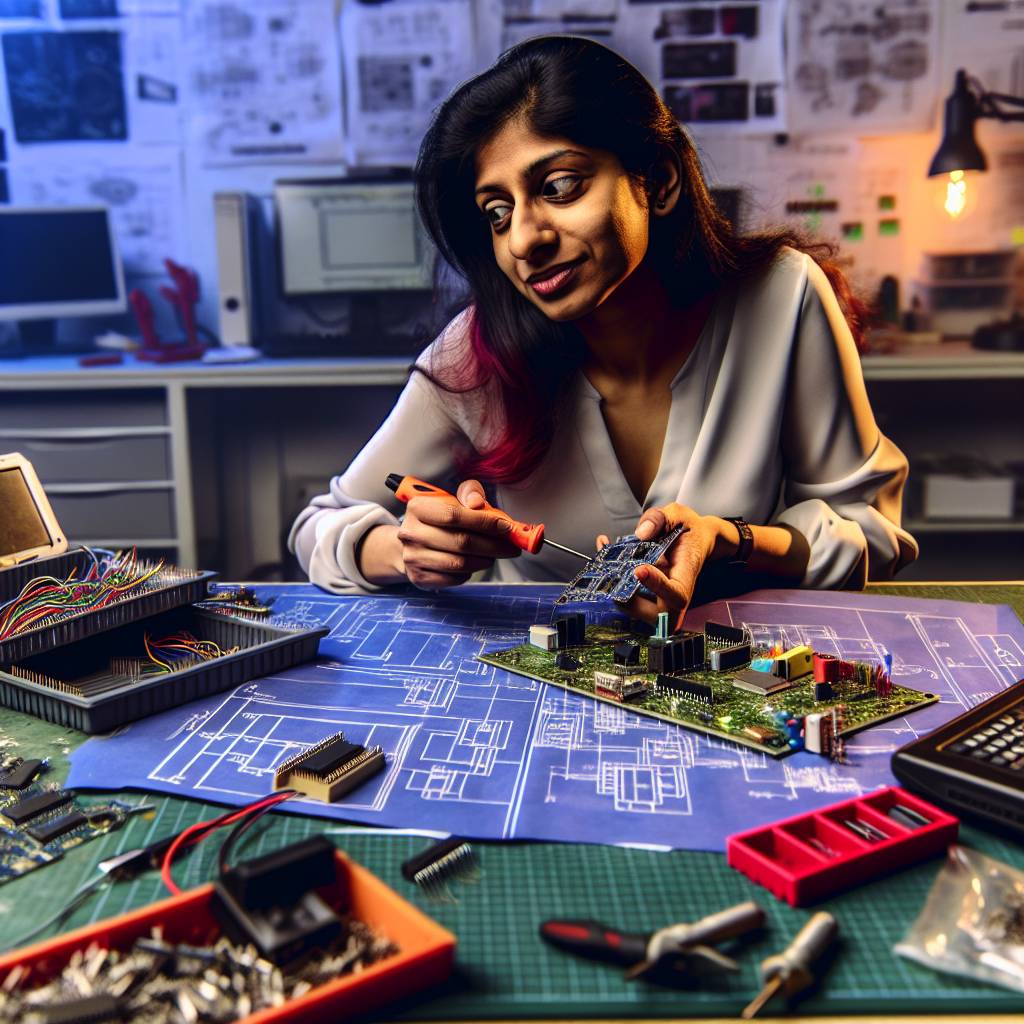Introduction:
In hardware engineering technology, advancements lead to faster and more efficient devices.
It is crucial to keep up with emerging trends to remain competitive in the industry.
The Internet of Things (IoT) in hardware engineering technology:
Definition of IoT
The Internet of Things (IoT) refers to the network of physical devices, vehicles, home appliances, and other items embedded with sensors, software, and connectivity which enables them to connect and exchange data.
These devices collect and exchange data, creating opportunities for more direct integration of the physical world into computer-based systems, resulting in improved efficiency, accuracy, and economic benefit.
How IoT is revolutionizing hardware engineering
IoT is revolutionizing hardware engineering by enabling devices to communicate, analyze data, and make decisions independently without human intervention.
This automation is transforming industries by improving operational efficiency, reducing costs, and enabling new business models.
Examples of IoT applications in hardware engineering
- Smart Homes – IoT devices like thermostats, lighting systems, and security cameras can be controlled remotely through smartphones, enhancing convenience and energy efficiency.
- Industrial Automation – IoT sensors are used to monitor equipment performance, detect maintenance issues, and optimize production processes in manufacturing plants.
- Healthcare – IoT-enabled medical devices like wearable fitness trackers and remote patient monitoring systems improve patient care, promote wellness, and facilitate early detection of health problems.
- Agriculture – IoT sensors help farmers monitor soil conditions, moisture levels, and crop health, enabling data-driven decision-making for irrigation and fertilization.
- Smart Cities – IoT technology is used to manage city infrastructure, monitor traffic flow, optimize waste management, and enhance public safety through surveillance systems.
- Retail – IoT devices like RFID tags and beacons track inventory levels, streamline supply chain management, and deliver personalized shopping experiences to customers.
Artificial Intelligence (AI) in Hardware Engineering Technology:
Artificial Intelligence (AI) has become a game-changer in the field of hardware engineering technology.
Its ability to analyze data, learn patterns, and make decisions has transformed the way hardware devices are designed, developed, and optimized for performance.
One of the key roles of AI in hardware engineering is optimizing performance.
Through machine learning algorithms, AI can analyze vast amounts of data to identify inefficiencies in hardware design.
By fine-tuning parameters such as power consumption, processing speed, and memory usage, AI can significantly improve the overall performance of hardware systems.
AI also plays a crucial role in hardware design and development processes.
By automating complex tasks such as circuit design, layout optimization, and testing, AI can streamline the hardware development cycle and reduce time-to-market.
This not only increases efficiency but also allows engineers to focus on more innovative and high-level tasks.
Looking ahead, the future prospects of AI integration in hardware engineering are promising.
As AI continues to evolve and become more sophisticated, we can expect to see even greater advancements in hardware performance, design complexity, and overall efficiency.
This will enable the development of cutting-edge hardware technologies that were once thought impossible.
Artificial Intelligence is revolutionizing the field of hardware engineering technology.
Its role in optimizing performance, impacting design processes, and shaping future prospects is undeniable.
Transform Your Career Today
Unlock a personalized career strategy that drives real results. Get tailored advice and a roadmap designed just for you.
Start NowAs we continue to innovate and explore the possibilities of AI in hardware engineering, the future looks brighter than ever.
Explore Further: Essential Tools for a Successful Technology Evangelist
Exploring the capabilities of 5G technology
5G technology, the fifth generation of cellular network technology, is poised to revolutionize hardware engineering.
With faster speeds, lower latency, and increased capacity, 5G has the potential to transform the way hardware is designed, developed, and utilized.
One of the key capabilities of 5G technology is its ability to deliver multi-gigabit per second data speeds.
This means that hardware engineers can work with larger datasets, process information more quickly, and enable real-time communication between devices.
In addition to speed, 5G technology offers ultra-low latency, which is critical for applications that require instantaneous response times.
Hardware engineers can leverage this low latency to create new and innovative products that were previously not possible with older-generation wireless technologies.
Furthermore, 5G technology enables massive device connectivity, allowing hardware engineers to design systems that can support a vast number of interconnected devices.
This opens up possibilities for the Internet of Things (IoT) applications, smart cities, and autonomous vehicles.
Potential uses of 5G in hardware engineering applications
The potential uses of 5G in hardware engineering applications are vast and diverse.
One major area where 5G technology can make a significant impact is in the realm of connected devices and IoT.
By leveraging the high speeds and low latency of 5G, hardware engineers can develop more advanced and sophisticated IoT devices.
These devices can communicate with each other in real-time, enabling seamless integration and automation of tasks.
5G technology can also be used in the development of autonomous vehicles.
The low latency of 5G networks ensures that critical information is transmitted instantaneously.
This allows vehicles to make split-second decisions and communicate with other vehicles on the road.
Moreover, 5G technology can enhance the capabilities of virtual and augmented reality (VR/AR) devices.
Hardware engineers can create immersive experiences with minimal lag and high-quality graphics, leading to more realistic and engaging user interactions.
Challenges and opportunities of implementing 5G in hardware design
While the potential of 5G technology in hardware engineering is immense, there are also challenges that need to be addressed.
Transform Your Career Today
Unlock a personalized career strategy that drives real results. Get tailored advice and a roadmap designed just for you.
Start NowOne of the main challenges is the cost of implementing 5G technology in hardware design.
5G infrastructure is expensive to deploy and maintain, which can increase the overall cost of hardware products.
Hardware engineers need to find ways to optimize designs and reduce costs without compromising on performance or quality.
Another challenge is ensuring compatibility and interoperability with existing hardware systems.
As 5G technology continues to evolve, hardware engineers must ensure that new designs are compatible with older devices and can seamlessly integrate with other systems.
Despite these challenges, there are significant opportunities for hardware engineers in implementing 5G technology.
By embracing 5G, engineers can develop cutting-edge products that deliver faster speeds, lower latency, and increased capacity.
This leads to enhanced user experiences and new business opportunities.
Uncover the Details: Virtualization Engineer: Automation and Scripting Skills
Quantum computing in hardware engineering technology:
- Understanding the basics of quantum computing
- How quantum computing can enhance hardware performance
- Current advancements in quantum computing research within hardware engineering
Quantum computing is a cutting-edge technology that has the potential to revolutionize the field of hardware engineering.
Unlike classical computers that use bits to represent data as either a 0 or 1, quantum computers use quantum bits or qubits.
Qubits can exist in a state of superposition, allowing them to represent a 0, 1, or any quantum superposition of these states simultaneously.
This property enables quantum computers to perform complex calculations at a much faster speed than classical computers.
Understanding the basics of quantum computing:
In quantum computing, qubits are the fundamental building blocks that carry information.
The key difference between classical bits and qubits is that qubits can exist in multiple states at once, thanks to superposition.
Another essential concept in quantum computing is entanglement, where the state of one qubit is dependent on the state of another, even when separated by large distances.
This phenomenon allows quantum computers to solve certain problems much more efficiently than classical computers.
How quantum computing can enhance hardware performance:
Quantum computing has the potential to significantly enhance hardware performance by tackling complex computations that are currently infeasible for classical computers.
Tasks that would take years for classical computers can be completed in a fraction of the time with quantum computers.
By harnessing the power of quantum parallelism and entanglement, quantum computers can solve optimization, simulation, and cryptography problems with unprecedented speed and efficiency.
Transform Your Career Today
Unlock a personalized career strategy that drives real results. Get tailored advice and a roadmap designed just for you.
Start NowThis opens up new possibilities for advancements in hardware engineering technology.
Current advancements in quantum computing research within hardware engineering:
Researchers and engineers are making remarkable progress in the field of quantum computing, pushing the boundaries of what is possible with this emerging technology.
One key area of focus is developing more stable and error-resistant qubits to improve the overall performance of quantum computers.
Additionally, advancements in quantum algorithms and error-correction techniques are paving the way for practical applications of quantum computing in hardware engineering.
As researchers continue to refine and expand quantum computing capabilities, the future of hardware engineering looks increasingly promising.
Explore Further: Telecommunications Specialist: Networking Tips for Success

Wearable technology in hardware engineering:
The rise of wearable technology in recent years has been remarkable.
Wearable devices like smartwatches, fitness trackers, and VR headsets have become increasingly popular.
Consumers are drawn to the convenience and functionality that these devices offer.
Tech companies are investing heavily in research and development to meet the growing demand for wearables.
Impact of wearable technology on hardware engineering innovation
The emergence of wearable technology has had a significant impact on hardware engineering innovation.
Engineers are now challenged to design smaller, lighter, and more energy-efficient hardware components.
The integration of sensors, processors, and batteries in compact form factors has become a key focus in hardware engineering.
Innovations in materials and manufacturing processes have enabled the production of flexible and durable wearables.
Challenges in designing hardware for wearable applications
Designing hardware for wearable applications comes with its set of challenges.
One of the main challenges is maintaining a balance between performance and power efficiency.
Engineers must also consider factors like size, weight, and durability when designing hardware for wearables.
Ensuring seamless integration of hardware components while maintaining user comfort is another critical aspect.
Wearable technology is driving innovation in hardware engineering.
The rise of wearables in consumer electronics is reshaping the way we interact with technology.
Transform Your Career Today
Unlock a personalized career strategy that drives real results. Get tailored advice and a roadmap designed just for you.
Start NowEngineers are constantly pushing the boundaries of hardware design to meet the demands of wearable applications.
Despite the challenges, the future of wearable technology in hardware engineering looks promising.
Uncover the Details: Building Long-Term Client Relationships as a TAM
Augmented Reality (AR) and Virtual Reality (VR) in hardware engineering:
– Adoption of AR and VR in hardware development
– Enhancing user experience through AR and VR technologies
– Future trends in AR and VR integration with hardware engineering
Adoption of AR and VR in hardware development
Augmented Reality (AR) and Virtual Reality (VR) are changing the way hardware is being developed.
Companies are increasingly incorporating AR and VR technologies in their hardware products to enhance user experience and functionality.
Hardware engineers are utilizing AR and VR to visualize complex designs and prototypes in a more immersive and interactive way.
This technology allows engineers to identify potential issues early in the development process.
They can make necessary adjustments without the need for physical prototypes.
Moreover, the adoption of AR and VR in hardware development has streamlined collaboration among team members located in different geographical locations.
With virtual meetings and shared VR spaces, engineers can work together in real-time on a project regardless of their physical location.
Enhancing user experience through AR and VR technologies
AR and VR technologies are revolutionizing user experience in hardware products.
From gaming to healthcare, these technologies are enhancing the way users interact with devices and applications.
In the gaming industry, VR headsets are providing users with immersive gameplay experiences that were previously unimaginable.
Users can now feel like they are inside the game, interacting with the virtual world in a way that feels almost real.
In healthcare, AR is being used to assist surgeons during complex surgeries.
It overlays vital information directly onto the patient’s body.
This technology improves the precision and accuracy of medical procedures, ultimately leading to better patient outcomes.
Transform Your Career Today
Unlock a personalized career strategy that drives real results. Get tailored advice and a roadmap designed just for you.
Start NowFuture trends in AR and VR integration with hardware engineering
The future of hardware engineering will likely see even greater integration of AR and VR technologies.
As these technologies continue to evolve and become more advanced, hardware engineers will have access to more powerful tools for design, testing, and collaboration.
One potential future trend is the use of AR and VR for virtual prototyping and testing.
Engineers may be able to simulate real-world conditions and scenarios in a virtual environment.
This will allow for more thorough testing and optimization of hardware designs before physical prototypes are produced.
Additionally, AR and VR may play a key role in the development of wearable devices and smart gadgets.
These technologies can enhance the user interface of these devices, making them more intuitive and user-friendly.
Emerging Trends in Hardware Engineering Technology
In recent years, hardware engineering has seen a significant shift towards more advanced technologies.
One key trend is the development of smaller, more powerful components that enable devices to be more compact.
Another trend is the rise of artificial intelligence and machine learning in hardware design, optimizing performance and functionality.
Furthermore, the integration of Internet of Things (IoT) capabilities into hardware is revolutionizing connectivity and data sharing.
The use of 5G technology is also shaping the future of hardware engineering, enabling faster and more efficient data transmission.
Embracing these emerging trends is crucial for staying competitive in the field of hardware engineering.
As technology continues to evolve, it is essential to adapt to new innovations and push the boundaries of what is possible in hardware design.
The future of hardware engineering looks promising with these trends, opening up new possibilities for innovation and growth.
The importance of embracing innovation and adapting to new technologies cannot be overstated in the ever-evolving landscape of hardware engineering.
Additional Resources
Computer and Information Technology Occupations : Occupational …
Software Developers, Quality Assurance Analysts, and Testers …




